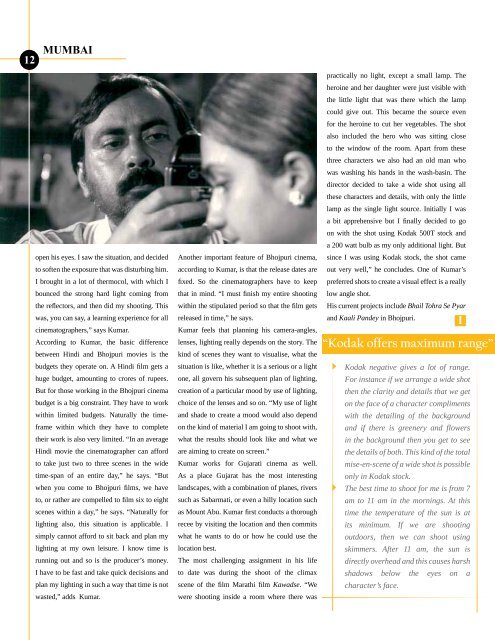READ MORE ABOUT AlsO fEATURED fOCUs ON - Kodak
READ MORE ABOUT AlsO fEATURED fOCUs ON - Kodak
READ MORE ABOUT AlsO fEATURED fOCUs ON - Kodak
You also want an ePaper? Increase the reach of your titles
YUMPU automatically turns print PDFs into web optimized ePapers that Google loves.
12<br />
MUMBAI<br />
open his eyes. I saw the situation, and decided<br />
to soften the exposure that was disturbing him.<br />
I brought in a lot of thermocol, with which I<br />
bounced the strong hard light coming from<br />
the reflectors, and then did my shooting. This<br />
was, you can say, a learning experience for all<br />
cinematographers,” says Kumar.<br />
According to Kumar, the basic difference<br />
between Hindi and Bhojpuri movies is the<br />
budgets they operate on. A Hindi film gets a<br />
huge budget, amounting to crores of rupees.<br />
But for those working in the Bhojpuri cinema<br />
budget is a big constraint. They have to work<br />
within limited budgets. Naturally the timeframe<br />
within which they have to complete<br />
their work is also very limited. “In an average<br />
Hindi movie the cinematographer can afford<br />
to take just two to three scenes in the wide<br />
time-span of an entire day,” he says. “But<br />
when you come to Bhojpuri films, we have<br />
to, or rather are compelled to film six to eight<br />
scenes within a day,” he says. “Naturally for<br />
lighting also, this situation is applicable. I<br />
simply cannot afford to sit back and plan my<br />
lighting at my own leisure. I know time is<br />
running out and so is the producer’s money.<br />
I have to be fast and take quick decisions and<br />
plan my lighting in such a way that time is not<br />
wasted,” adds Kumar.<br />
Another important feature of Bhojpuri cinema,<br />
according to Kumar, is that the release dates are<br />
fixed. So the cinematographers have to keep<br />
that in mind. “I must finish my entire shooting<br />
within the stipulated period so that the film gets<br />
released in time,” he says.<br />
Kumar feels that planning his camera-angles,<br />
lenses, lighting really depends on the story. The<br />
kind of scenes they want to visualise, what the<br />
situation is like, whether it is a serious or a light<br />
one, all govern his subsequent plan of lighting,<br />
creation of a particular mood by use of lighting,<br />
choice of the lenses and so on. “My use of light<br />
and shade to create a mood would also depend<br />
on the kind of material I am going to shoot with,<br />
what the results should look like and what we<br />
are aiming to create on screen.”<br />
Kumar works for Gujarati cinema as well.<br />
As a place Gujarat has the most interesting<br />
landscapes, with a combination of planes, rivers<br />
such as Sabarmati, or even a hilly location such<br />
as Mount Abu. Kumar first conducts a thorough<br />
recee by visiting the location and then commits<br />
what he wants to do or how he could use the<br />
location best.<br />
The most challenging assignment in his life<br />
to date was during the shoot of the climax<br />
scene of the film Marathi film Kawadse. “We<br />
were shooting inside a room where there was<br />
practically no light, except a small lamp. The<br />
heroine and her daughter were just visible with<br />
the little light that was there which the lamp<br />
could give out. This became the source even<br />
for the heroine to cut her vegetables. The shot<br />
also included the hero who was sitting close<br />
to the window of the room. Apart from these<br />
three characters we also had an old man who<br />
was washing his hands in the wash-basin. The<br />
director decided to take a wide shot using all<br />
these characters and details, with only the little<br />
lamp as the single light source. Initially I was<br />
a bit apprehensive but I finally decided to go<br />
on with the shot using <strong>Kodak</strong> 500T stock and<br />
a 200 watt bulb as my only additional light. But<br />
since I was using <strong>Kodak</strong> stock, the shot came<br />
out very well,” he concludes. One of Kumar’s<br />
preferred shots to create a visual effect is a really<br />
low angle shot.<br />
His current projects include Bhail Tohra Se Pyar<br />
and Kaali Pandey in Bhojpuri.<br />
“<strong>Kodak</strong> offers maximum range”<br />
<strong>Kodak</strong> negative gives a lot of range.<br />
For instance if we arrange a wide shot<br />
then the clarity and details that we get<br />
on the face of a character compliments<br />
with the detailing of the background<br />
and if there is greenery and flowers<br />
in the background then you get to see<br />
the details of both. This kind of the total<br />
mise-en-scene of a wide shot is possible<br />
only in <strong>Kodak</strong> stock.<br />
The best time to shoot for me is from 7<br />
am to 11 am in the mornings. At this<br />
time the temperature of the sun is at<br />
its minimum. If we are shooting<br />
outdoors, then we can shoot using<br />
skimmers. After 11 am, the sun is<br />
directly overhead and this causes harsh<br />
shadows below the eyes on a<br />
character’s face.<br />
I

















